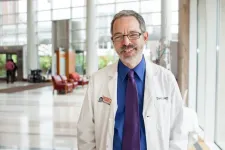(Press-News.org) September 29, 2023, CLEVELAND: A team from Cleveland Clinic has developed a new model for prioritizing patients waiting for a lung transplant, aimed at improving outcomes and reducing deaths among those in need of donor lungs. The new method offers an improved strategy for organ allocation by taking into account how the time a patient has spent on the waiting list could impact the severity of their disease and the urgency of their need for a transplant.
The results of a study looking at this new method were published today in The American Journal of Respiratory and Critical Care Medicine.
Currently, lung transplant candidates are ranked by a scoring equation called the Composite Allocation Score (CAS). Candidates are assigned a number based on factors including how stable they are while waiting, chances of survival after receiving a new organ, and how easily they can be matched for available organs. Those with the highest scores are given priority and offered donor lungs first. However, the scores are based on tests given twice a year at transplant centers. That means that unless a patient’s health suddenly and drastically changes, their score will remain the same for at least six months.
“The problem with this method is that the scoring equations fail to consider how a patient’s health status changes as they spend more time on the list,” said Maryam Valapour, M.D., M.P.P., director of Lung Transplant Outcomes at Cleveland Clinic. “The longer a patient lives with a severe lung disease, the more their risk of developing severe complications increases. This is something clinicians observe every day – that our patients’ risk of developing complications changes over time. Therefore, some patients’ scores may not reflect how urgently they need a transplant.”
To determine how the amount of time on the waitlist affects clinical outcomes, the team of researchers analyzed data from 12,000 American adults listed for lung transplant between 2015 to 2020. The study showed that for many patients, their risk of death prior to transplant increased as they spent longer times waiting for donor lungs.
When the team looked at patients who died on the waiting list, they found that many had not been given enough priority in the CAS. To more accurately score the candidates, the team developed a more dynamic method called the multistate composite model that accounted for the type of lung disease and time on the waiting list. When they recalculated the original scores with their new equation, it consistently marked those patients as high priority. However, for patients who originally received low-priority scores and remained stable over time, using the new method did not change their scores.
“The approaches we present in our paper are capable of identifying whose trajectory is more stable on the waiting list versus those whose trajectory is worsening between six-month clinical updates. The estimates in our model more closely align with observed trends in individual U.S. lung transplant patients,” says Jarrod Dalton, Ph.D., director of Lerner Research Institute’s Center for Populations and Health Research, who is first author of the paper. “This approach may allow us to more accurately prioritize time-sensitive lung transplant candidates and decrease waitlist mortality for patients with end-stage lung disease.”
This study was done with the support of the National Institutes of Health.
“This research advances us towards development of a more comprehensive prediction model for risk of mortality among lung transplant candidates that could help guide decisions about patients who are in greater need for lung transplant and increase their odds for survival,” said James P. Kiley, Ph.D., director of the Division of Lung Diseases at the National Heart, Lung, and Blood Institute (NHLBI).
In 2022, there were over 3,000 candidates added to the lung transplant waitlist with over 2,600 lung transplants performed, according to UNOS. While the numbers of donors and transplants are improving, there is still a shortage of available organs in the United States.
Research reported in this publication was supported by the National Institutes of Health under Award Number R01HL153175. The content is solely the responsibility of the authors and does not necessarily represent the official views of the National Institute of Health.
About Cleveland Clinic
Cleveland Clinic is a nonprofit multispecialty academic medical center that integrates clinical and hospital care with research and education. Located in Cleveland, Ohio, it was founded in 1921 by four renowned physicians with a vision of providing outstanding patient care based upon the principles of cooperation, compassion and innovation. Cleveland Clinic has pioneered many medical breakthroughs, including coronary artery bypass surgery and the first face transplant in the United States. Cleveland Clinic is consistently recognized in the U.S. and throughout the world for its expertise and care. Among Cleveland Clinic’s 77,000 employees worldwide are more than 5,658 salaried physicians and researchers, and 19,000 registered nurses and advanced practice providers, representing 140 medical specialties and subspecialties. Cleveland Clinic is a 6,699-bed health system that includes a 173-acre main campus near downtown Cleveland, 23 hospitals, more than 275 outpatient facilities, including locations in northeast Ohio; southeast Florida; Las Vegas, Nevada; Toronto, Canada; Abu Dhabi, UAE; and London, England. In 2022, there were 12.8 million outpatient encounters, 303,000 hospital admissions and observations, and 270,000 surgeries and procedures throughout Cleveland Clinic’s health system. Patients came for treatment from every state and 185 countries. Visit us at clevelandclinic.org. Follow us at twitter.com/ClevelandClinic. News and resources available at newsroom.clevelandclinic.org.
Editor’s Note: Cleveland Clinic News Service is available to provide broadcast-quality interviews and B-roll upon request.
###
END
The University of Virginia School of Medicine’s Mariano A. Garcia-Blanco, MD, PhD, will be inducted this weekend into the American Academy of Arts and Sciences (AAAS), one of the country’s oldest and most prestigious honorary societies, in recognition of his exceptional scientific contributions.
The AAAS was founded in 1780 – during the Revolutionary War – by John Adams, John Hancock and other founding fathers who wanted to “cultivate every art and science which may tend to advance the interest, honor, dignity and ...
URBANA, Ill. — As we hurtle toward crucial tipping points on a warming planet, an international team of scientists is recruiting a surprising ally to make a powerful dent in greenhouse gas emissions: the cow. Animal sciences researchers from the University of Illinois Urbana-Champaign are driving a new project to reduce methane production resulting from rumen fermentation in beef and dairy cattle. The 3-year, $3.2-million project is part of the Greener Cattle Initiative, led by the Foundation for Food and Agriculture Research (FFAR).
According to the researchers, aggressively targeting methane could help course-correct our climate trajectory on a quicker timeline ...
WASHINGTON, D.C. — The U.S. Department of Energy (DOE) today announced $264 million in funding for 29 projects to develop solutions for the scientific challenges underlying DOE’s Energy Earthshots™ Initiative to advance clean energy technologies within the decade. The funding will support 11 new Energy Earthshot Research Centers led by DOE National Laboratories and 18 university research teams addressing one or more of the Energy Earthshots™ that are focused on six different areas, including industrial decarbonization, carbon storage, and offshore wind. The Department launched the Energy Earthshots ...
A top UVA Health cancer expert is highlighting how a new drug could transform how doctors treat a brain tumor that typically strikes younger people.
David Schiff, MD, the co-director of UVA Cancer Center’s Neuro-Oncology Center, has authored an editorial in the prestigious New England Journal of Medicine describing the potential significance of the drug vorasidenib for patients with tumors known as “grade 2 IDH-mutant gliomas.” The drug, when tested in the INDIGO clinical trial, was found to slow tumor growth significantly and extended the average time until the tumor started growing from 11.1 months ...
An international team of researchers has released a landmark study on contemporary evolutionary change in natural populations. Their study uses one of the largest genomic datasets ever produced for animals in their natural environment, comprising nearly 4,000 Darwin’s finches. The study has revealed the genetic basis of adaptation in this iconic group. The results are published in the journal Science.
Ever since Darwin wrote about the finches of the Galápagos Islands, biologists have studied these small songbirds to understand the mechanisms of evolution. One ancestral species has evolved into 18 different species in the last million years. ...
Chemical engineering researchers have a powerful new tool at their disposal: active machine learning. In a recent perspective article published in Engineering, Kevin M. Van Geem’s research team at Ghent University explores the potential of active machine learning in revolutionizing the field of chemical engineering. By combining machine learning with the design of experiments, active machine learning promises to enhance the efficiency and cost-effectiveness of research, spanning all length scales of chemical engineering.
Active machine learning algorithms ...
A new article published in PeerJ Life & Environment, authored by Camila Ferreira Leão at Universidade Federal do Pará sheds light on the effects of climate change on carnivorous mammals in the Amazon and their representation within Protected Areas (PAs). "Climate change and carnivores: shifts in the distribution and effectiveness of protected areas in the Amazon," reveals alarming findings about the vulnerable status of these animals and the effectiveness of conservation measures.
Carnivorous ...
Research has shown that personal narratives—the stories we tell ourselves about our lives—can play a critical role in identity and help us make sense of the past and present. Research has also shown that by helping people reinterpret narratives, therapists can guide patients toward healthier thoughts and behaviors.
Now, researchers from the Positive Psychology Center at the University of Pennsylvania have tested the ability of ChatGPT-4 to generate individualized personal narratives based on stream-of-consciousness thoughts and demographic details ...
A research team led by Professor Tianyou Chai from Northeastern University, China, has developed an innovative intelligent control method for the low-carbon operation of energy-intensive equipment. This groundbreaking research, published in the journal Engineering, presents a significant step towards reducing carbon emissions in the process industry.
The research team’s method combines mechanism analysis with deep learning, linking control and optimization with prediction, and integrating decision-making ...
A research team from Central South University in China develops innovative control method to reduce carbon emissions from zinc oxide rotary kilns.
The zinc smelting industry is facing new challenges in meeting China’s carbon peak and carbon neutrality targets. To address these challenges, researchers from Central South University in China have developed a groundbreaking control method that reduces carbon emissions from zinc oxide rotary kilns while maintaining high profits. Their findings have been published in the journal Engineering.
Zinc oxide rotary kilns play a crucial role in the zinc smelting process. ...






